
Subliminal messages are a marketers dirty little secret.
They are used to appeal to the viewers’ unconscious brains and affect their behavior or opinions without them noticing.
Anyone who’s seen that episode of Friends where Chandler uses a hypnosis tape to quit smoking but wakes up as a strong independent woman, has probably wondered if their brain can really be affected so strongly by subliminal messages.
As a result, subliminal messages have often had negative connotations, and the idea that marketers are deceiving their customers with these undetectable signals can be a reputational nightmare for a brand.
Many countries even banned subliminal advertising after a scare in the 1950s.
And whilst movie supervillains might use subliminal messages in this way, the term ‘subliminal messages’ covers a broad range of (mostly) harmless techniques. In fact, there are plenty of brands that use positive subliminal messages in their marketing strategies.
Telling people something good about your brand is, after all, the key goal of most marketing. So we might as well utilize all the tools, right?
Table of Contents
What are subliminal messages?
At this point, there’s probably a good number of people asking themselves “what are subliminal messages exactly”. So let us explain.
There are high chances that you have been affected by subliminal messages at least once in your life, either by brands or movies and artists, as they are not always used in a commercial sense.
A good example of this is when subliminal messages were famously used in the movie The Exorcist to heighten the emotions of terror and fear when an image of a death mask was flashed for a fraction of a second at key moments of the film, not in a commercial purpose but an artistic one.
Subliminal advertising on the other hand is a part of a marketing niche called neuromarketing. Subliminal perception is when your brain receives signals “below the absolute threshold level” of your conscious awareness. The word “subliminal” literally means “below threshold.”
Hence, subliminal messages are undetectable by the conscious mind.
Subliminal messages are targeted to influence people without them noticing, rendering them unable to make conscious decisions about the messages they are consuming.
Subliminal messages in advertising are usually either auditory or visual signals that are detected by your subconscious brain, which then tries to process or decode these signals without you being consciously aware of them.
And whilst some may attempt to use subliminal messages for nefarious means, advertisers simply want to encourage you to buy more of their products, associate a certain feeling with their brand or keep their brand on top of mind.
Types of subliminal messages
Whilst subliminal messages can be received by any of the senses, in marketing the most common are visual subliminal messages and auditory subliminal messages.
Auditory Subliminal Messages
There are two types of auditory subliminal messages:
- Backmasking
- Subaudible messaging
Backmasking
Backmasking is primarily used in songs, radio or other audio recordings.
An audio recording of speech, whisper or singing is played backwards into the original recording and is therefore not detectable consciously.
It is believed that listeners subconsciously detect the message as their brains try to decode it.
Backmasking subliminal messages is a common trope in metal and rock music. Many of the most famous bands of the 60’s and 70’s were accused of backmasking subliminal messages into their songs, including Queen, The Beatles, Led Zeppelin.
It’s said many bands backmasked messages about satan, drugs, sex and violence into their music, causing heated discussions about the terrible effects of subliminal messages.
Pastors claimed that backmasking was the devil’s work, while audio engineers say it’s nearly impossible to make lyrics sound right backwards and forwards.
Subaudible Messaging
Another kind of auditory subliminal messages are subaudible messaging, which is similar to backmasking, but the recording is played forward, so an audio recording is inserted into another audio file.
The message is typically of lower volume than the primary audio and falls into the rhythm. The message is therefore undetectable, but it’s still there for the brain to store and decode.
Examples of subaudible messages are typically whispered words or sounds in background music with the intention to relax, engage with or sell to customers.
Visual Subliminal Messages
There are two types of visual subliminal messages:
- Subvisual messaging
- Embeds
Subvisual Messaging
These are frames that are flashed quickly in a video for a fraction of a second, so fast that viewers don’t notice them. This is also referred to as “priming” and is not used as much in marketing today as it was before.
This will typically be the logo of a business or imagery/words with positive or negative connotations.
Embeds
Embeds are static images that are embedded into another image, hidden in plain sight. These can be online, posters, newspapers, magazines, billboards or TV.
Embedded subliminal messages are subtle cues to get some message across, that you don’t recognize immediately but your brain might still store them.
This type of subliminal messages is possibly the most commonly used in marketing today, which shows in the subliminal messages examples below.
16 Subliminal Messages Examples
To help you appreciate and understand that subliminal messages aren’t so scary, it’s helpful to see some good subliminal messages examples in action.
Subliminal advertising, like any other tool, can be great when used right, but can also have negative effects if used incorrectly. Let’s take a look at some:
1. The FedEx logo

FedEx’s logo is a great example of subliminal messages done right.
As you can see in the above image, the logo simply says FedEx in purple and orange letters. But if you look closer there’s actually a hidden arrow between the letters E and x.
The arrow is not immediately visible or highlighted in any way – most consumers don’t notice it. But the arrow’s placement is purposeful, sending you a subtle message about the brand. The arrow could represent speed, movement or delivery.
The name FedEx has no meaning if you don’t already know the company, but the arrow signals its essence subconsciously, triggering consumers to associate the brand with timely delivery.
Moreover, when you see the arrow, the response is likely to be impressed by its subtleness and cleverness, right? Here we see subliminal messages used in a positive and engaging way.
2. Amazon’s logo
Amazon’s logo is another good example of positive subliminal messages.
The logo consists of the company’s name in black letters, and a curved arrow connecting the letters a and z. The arrow connecting the two letters implies “we have everything from A to Z”.
The arrow is also a crooked smile, signaling happiness, happy customers or just general positivity. Amazon wants us to associate their brand with satisfied customers and a great variety of products.
Arrows are a universal symbol that represents directions, and most of us take note of arrows. It’s not a coincidence that two giant companies like FedEx and Amazon use them in their subliminal messages.
3. KFC’s hidden dollar bill
This KFC TV commercial from 2008 launched a new product called the KFC Snacker caused a lot of discussion about subliminal messages.
The image looks like just another unassuming burger, but if you look very closely at the salad, there’s a green $1 dollar bill hidden in it.
Those customers who spotted the bill wondered what KFC was trying to accomplish. KFC’s answer was that it was a part of a contest, offering $1 coupons to the first 1000 viewers to spot it, but no information was provided about how to sign up.
If we look at the contest, making people scan an ad closely in order to win a prize, looking for a hidden bill and then getting the feeling of “finding money”, it’s a brilliant marketing strategy.
You trigger a good feeling associated with your brand, brand awareness and customer loyalty. A great way to hold people’s attention for a longer period of time and pay attention to your ad.
If we look at the subliminal messages, KFC wanted customers to associate this new burger with a one dollar bill, hinting that it’s affordable, potentially triggering increased purchase frequency.
Reframing the customer perception that the product is good value for money. The image of a bill could also be associated with luxury.
A quite successful strategy, apart from the confusion in the beginning.
4. McDonald’s and Food Networks “mistake” priming
In 2007, the McDonalds logo was flashed for a fraction of a second on the Food Network while broadcasting The Iron Chef, raising the question – were these subliminal messages?
When consumers realized what had happened, both companies’ reputations suffered as viewers felt deceived.
The Food Network said it was a glitch, and McDonald’s claimed they did not use subliminal messages in advertising.
True or not, this is not a good example of positive subliminal messages. McDonald’s intention was likely to affect customers’ choice over other brands, assuming viewers were getting hungry from watching Iron Chef. But it leaves watchers deceived and treated.
5. Wendy’s family values
Wendy’s is a large American fast food chain founded back in the 1960s.
In 2012 they rebranded and released a new logo.
If you take a good look at the new logo, there are subliminal messages in the logo. The word MOM is hidden in Wendy’s clothes.
Wendy’s is reinforcing their brand’s “family values” by associating themselves with the idea of a mom, home-cooked food and all the good feelings associated with mothers.
On the other hand, some marketers felt a fast food chain is very far from home-cooked food, and therefore a bad strategy to associate with something your product doesn’t deliver.
The subliminal perception of the logo is probably personal, but it’s food for thought on subliminal messages and underlines that it can be hard to get it right. You have to deliver on what you’re promising.
6. Gilbey’s Gin promises sex
Gilbey’s Gin released this poster ad with a photo of their Gin bottle and a tall Gin & Tonic beside it. The photo sparkles and the bottle is dripping, undoubtedly ice cool and refreshing, making all of us wish we had this drink in our hand.
If we take a closer look at the Gin & Tonic, specifically the ice in the glass, the word SEX is hidden there, one letter in each ice cube. Gibley’s is testing embedded subliminal messages.
They want you to associate the same ideas you associate with sex, with their drink. Hence, good feelings and fun (we hope).
As Emily Friedman once said, “If there’s one thing that every marketing and advertising pro retained from Business 101 class, it’s that sex sells.”
7. Coca Cola’s curves
This Coca Cola poster was a part of a campaign in Australia released in the mid-1980s.
At first glance, this appears to be a bottle of Coca Cola, surrounded by ice cubes and says “Feel the curves!!”
But hidden in between the ice is a woman performing a sex act. It appears sex is a huge theme in subliminal messages.
Coca Cola insisted this was not a case of embedded subliminal messages and apparently filed a complaint against the artist who made the poster.
Again we will never know if that’s true or not, but the subliminal messages would align the slogan; “feel the curves” is most probably a reference to the curves of a woman’s body and many claim the bottle is shaped like one.
So a woman performing oral sex is not so far off to underline that message! Very clever!
Some of these posters still exist and are sold for hundreds of dollars online, so the campaign and the subliminal messages did acquire Coca-Cola some fans, fame and brand awareness.
8. Benson & Hedges’ masculinity
Benson & Hedges is a British cigarette brand sold all over the world with a few exceptions.
This printed ad was released when they introduced their hard packs. Previously their cigarettes had only been available in soft packs.
It’s a photo of a couple embracing, in which the woman looks lustfully at the man, and the man looks at the viewer with a knowing smile.
The ad says “If you got crushed in the clinch with our soft pack, try our hard pack.”
Harmless enough, right? But if we look closer we find examples of subliminal messages. The man’s hands are holding the woman’s back. Looked closely at his left hand, it’s holding an erect penis, airbrushed into the woman’s back.
Back in the day, cigarettes were marketed primarily towards men, so putting the emphasis on manhood and masculinity was probably a winning formula.
It also can’t be a coincidence that they’re introducing their hard packs, hiding subliminal messages of a hard penis.
This ad is selling you masculinity and sexual excitement and the phallus is said to stimulate sexual anxiety, both feelings that trigger the longing for a smoke.
Tobacco companies have been known to use subliminal messages as well as supraliminal (signals detected consciously, read further for more information) messages to trigger cravings for a cigarette and try to increase the frequency of purchase.
9. Husker Du
The board game Husker Du was released in the 1950s.
It’s a memory game where both adults and children can compete, and the slogan claimed it to be a game “in which the child can outwit the adult.”
During the Christmas season in 1973, an ad for Husker Du was aired on TV where the subliminal message “get it” flashed across the screen for a very short time.
Until this day there’s no research that supports the use of subliminal messages in this way, although a useful marketing tool, subliminal messages cannot enforce an action (at least so we know).
This ad heightened the already heated discussions about subliminal messages, and more people were asking “what are subliminal messages”?
The ad is said to be the reason that the FCC originally made the statement against subliminal advertising in the USA, claiming it would revoke the broadcasting license from companies using subliminal advertising.
10. SFX Magazine

Once again we’re in the theme of SEX, and SFX does it brilliantly.
SFX, a magazine that specializes in pop culture, covers a part of the title of the magazine every once in a while.
After a little research, this appears to happen very often when there’s an attractive woman on the cover.
For a second you might therefore think that the magazine covers more explicit content than they actually do, because of their use of subliminal messages. This grabs your attention for longer than it otherwise would and triggers your excitement for a brief (or long) moment.
Even after you realize what they’re on to, you’re left with a smile on your face.
11. Tostitos
The Tostitos logo is also a well-known example of subliminal messages in advertising.
Their logo simply reads Tostitos, but in the middle of the logo, the letters t-i-t are double agents. Namely, they are also a couple of friends sharing a bowl of chips and dip together.
This image creates the feeling of togetherness, friendship and good memories which are then associated with their brand.
Tostitos are comfort food, and this image underlines their values, plus the product delivers what’s promised!
Brilliant execution and one of many good examples of positive subliminal messages.
12. Burger King’s suggestive campaign
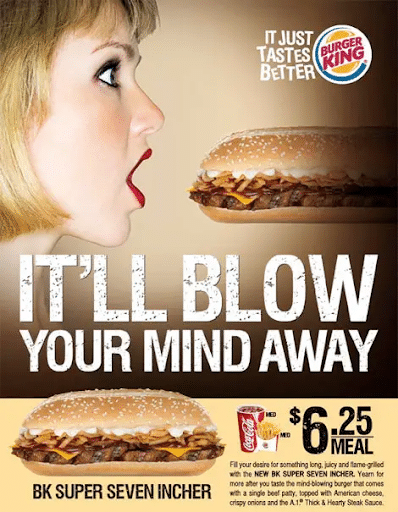
In 2009, Burger King ran a campaign to introduce its new super seven-inch burger. The campaign featured a gaping surprised-looking woman with red lipstick and the caption was “It’ll blow your mind away”.
Now, the message here isn’t very subtle and frankly quite tactless. For sure, one of those jokes that just don’t age well.
Although this kind of ad might hit right for some audiences and is certainly an example of subliminal messages that makes people look again, it’s also another example of marketers remembering only one thing from their marketing studies – sex sells.
It’s bad for a number of reasons. Very few people affiliate Burger King with anything sexual so it’s an odd choice of message, and makes you wonder if there were really no other good ideas? It’s perhaps letting customers “in on the joke”, creating stigma and attention – but is all attention good attention? In our opinion, it’s a shoot-and-miss.
What do you think?
13. Toblerone’s connection to its roots
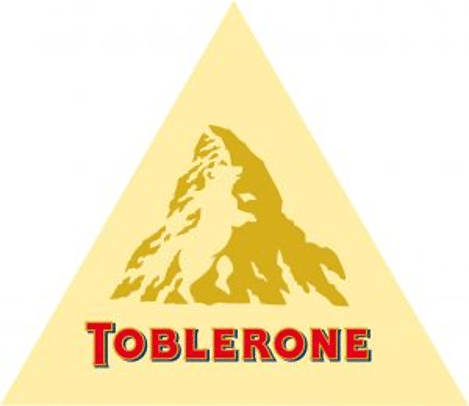
Toblerone is originally from Switzerland’s capital Bern.
The logo is a visual of a mountain, supposedly the Swiss alps. If we look closer there’s also a bear on its hindlegs hiding in the logo.
Bern is sometimes referred to as “the city of bears”, and their coat of arms is an image of a bear.
Toblerone’s logo pays tribute and is a subliminal reminder of its place of origin.
Switzerland has long been known for quality and stability. Marketers have used the country’s image in their strategy, for example, the Swiss Army knife and Swiss Miss (even though not from Switzerland).
The Swiss connection increases the brand’s authority, trustworthiness and signals quality.
14. NBC

Not everyone knows it, but NBC’s logo is in fact a colourful peacock, and its inspiration is the saying “proud as a peacock” – giving the brand a sophisticated and proud complexion.
The colourful aspect is important in a historical sense, as the colours represent the introduction of colour TV. The six colours also represent the six divisions of NBC.
If we turn our focus to the subliminal messaging aspects of the logo, it’s telling us a great many things at the same time, which all could be considered subliminal messages.
The proudness of the peacock is probably the one that’s most likely to make an impression on customers. The proud peacock increases the brand’s authority and the colourfulness of the logo boosts the brand’s awareness as it doesn’t go unnoticed.
15. Baskin Robbins 31 flavours of Icecream
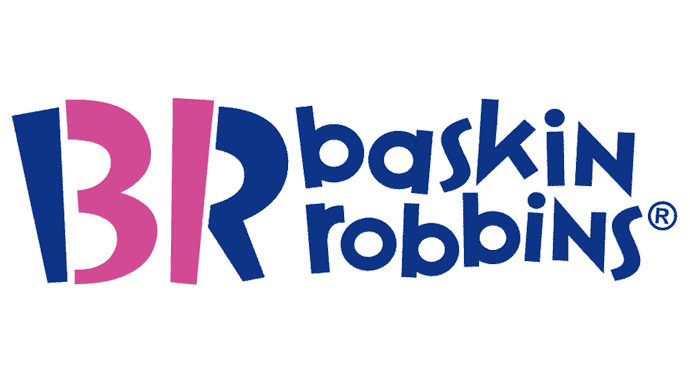
Basking Robbins is a famous American ice cream brand.
It famously has 31 different flavours of ice cream that you can taste-try until you find the one you like, which was the two founder’s motto.
Its logo includes the brand’s initials BR, but the BR also form the number 31 in a pink colour, different than the rest of the text.
This logo is a head-turner that subliminally messages its core feature. It’s excellently executed and not likely consumers will forget, once they notice.
16. Coca cola and pepsi’s Halloween campaigns
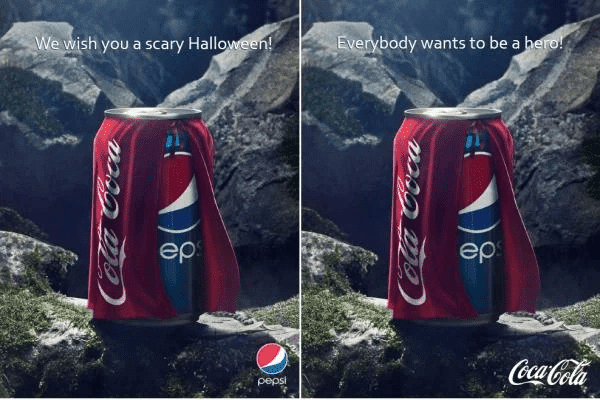
Pepsi’s ad on the left was a part of a campaign that ran right before Halloween. It’s a relatable joke for Pepsi fans, that probably agree that it’s scary to get a Coke when you really want Pepsi.
Coke’s response to Pepsi’s campaign was just as good, playing into a famous rivalry between the competitors. Coke used the same imagery but changed the tagline and thereby the agenda. Brilliant!
The image itself without the taglines can be interpreted differently as a subliminal message – either in favour of Coke or Pepsi depending on how you look at it. This is therefore an example where the tagline really makes the ad.
This subliminal advertisement was received well by fans on each side and was generally considered a good joke, entertaining and keeping both brands top of mind.
What aren’t examples of Subliminal Messages?
A lot of people mix up the difference between Subliminal messages and Supraliminal messages.
Subliminal messages are just one way to send messages that you’re not aware of.
Supraliminal messages are messages that are detectable by the conscious mind but are often disguised. This can be literally anything but in advertising most often auditory messages, visual images or videos.
Product placement, influencer marketing, background music and the whole idea of emotional branding are also ways to send you signals, not subconsciously but not necessarily received with full attention either.
Here are a few examples of non subliminal messages:
Music choice in stores
A British supermarket conducted research about purchases of wine in their stores. They had the same French and German wine showcased side by side.
On selected days they played French music, resulting in higher sales of French wine, and likewise an increase in sales of German wines when German music was played.
Music is not subliminal – it’s detectable by the conscious mind – but nonetheless, we’re not always aware of how music affects our mood and decisions.
Further research conducted in 1982 showed that the tempo of music played in stores had a significant effect on customers. Playing slow tempo music increased sales by 38.2% compared to when fast tempo music was played.
Again this is not subliminal messaging at all, but a supermarket trying to create an environment that’s safe and comfortable, encouraging consumers to stay and shop.
Product placement
Product placement in song lyrics is a tale as old as time and product placement has been an integral part of the movie business from its beginnings.
Every time Kanye West drops a line like “Stay Jordan fresh, suits and Ferraris / Cute, your shorty watch Barney, we at the Barneys”, or when Sister Sledge sings “Halston, Gucci, and Fiorucci. He looks like a still, that man is dressed to kill”, our consumer behaviour is impacted.
The same goes when brands buy advertisements as product placement in music videos, TV shows or movies.

Influencer marketing
Influencer marketing is relatively new to digital marketing, though word of mouth has long been a known concept of traditional marketing.
Influencers on Social Media get paid to showcase various products, clothes, apps, music and really anything and everything on their own personal platform.
As a result, the viewer doesn’t always know when they’re looking at an ad and when not.
Influencer marketing has been around for some time now, and in numerous countries influencers have to label content as an #ad when they’re getting paid to showcase something, or when they’ve gotten something for free, changing the industry significantly.
Nonetheless, experts say influencer marketing is here to stay and is a good example of product placement. We did another blog about the best podcast for Social Media marketing for those who want to do further research.
Do Subliminal Messages Work?
The use of subliminal messages as a tool to influence people has been around for some time.
Some argue its existence can be traced back to Greek thinkers, using subtle yet persuasive language to surreptitiously influence people in the 5th century BC.
One of the first recorded subliminal message examples is from 1947 when BUY BUDS flashes on and off screen faster than the human eye is able to consciously detect in an episode of Daffy Duck.
At the time no one knew if this kind of advertising worked, but why not try?

Subliminal messages first became a buzzword in the 1950s, after James Vicary published a study stating that he dramatically increased sales of Coca Cola and popcorn in movie theatres by priming the words “Hungry? Eat popcorn” and “Thirsty? Drink Coca Cola” during a movie.
A few years later Vicary admitted to having faked the study, but there was no turning back. Vicary’s study had led to a moral panic, resulting in subliminal messages being banned in Australia and the UK in 1958.
Since then, researchers have done numerous studies on subliminal messages and the effects they have on people. Researchers mostly agree that subliminal messages don’t have as much impact as originally thought.
However, research has shown that subliminal messages in advertising work if certain conditions are met, such as if people already have the need for the product.
One of the most famous studies on subliminal messages in advertising is from 2006, where a photo of Lipton Ice Tea was flashed, affecting participants’ choice over other beverages, but only if they were already thirsty.
Subliminal messages also work well to associate your brand with certain feelings or adjectives.
A study at the University of Washington in which participants were primed (quickly flashed) with a word, followed by an above-the-threshold word (detectable by the conscious brain) showed that participants’ judgement of the latter word was affected by the priming.
Another study showed that students who were flashed the Apple logo found more creative solutions than those flashed with the IBM logo, and those primed with Disney images were more honest than participants who were primed with content from E! Entertainment.
There’s a reason we connect creativity, simple design, success and Steve Jobs with the Apple brand, and the reason is our semantic network, which can be affected by subliminal messages.
Numerous companies have done this successfully, as shown in the subliminal messages examples above.
Conclusion
Subliminal messages can be the cherry on top of your marketing strategy.
It can be hard to get it right, but well worth the effort.
The important thing is to use subliminal messages positively and let your customers in on the joke instead of trying to deceive them.
Marketers should also focus on customers who they know have a need for their product to trigger choices, and given the current data-driven digital marketing environment, there are plenty of chances to try subliminal messages.
Don’t try to reinvent the wheel, learn from those who have been successful, learn from Apple’s strategy and trigger customers’ semantic network to help them relate positively to your brand or underline the values of your organization via positive subliminal messages.

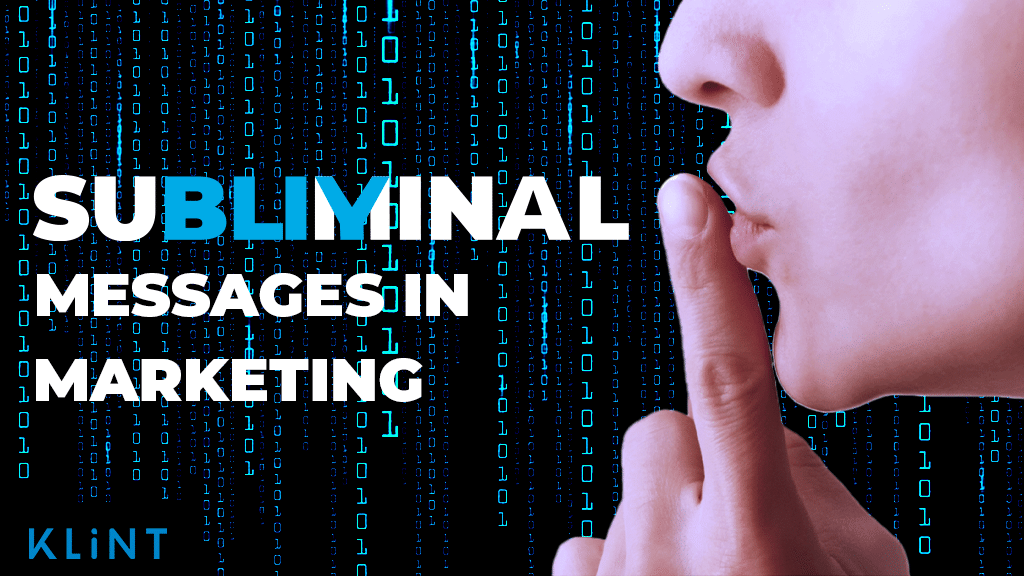

![35 Examples of Rebranding Fails And What We Can Learn [2021 Update]](https://klintmarketing.com/wp-content/uploads/2021/09/Rebranding-fails-feature-image-1080x675.jpg)

0 Comments